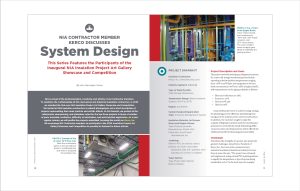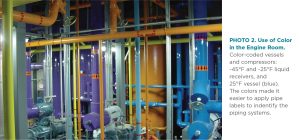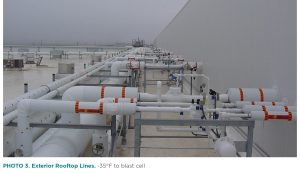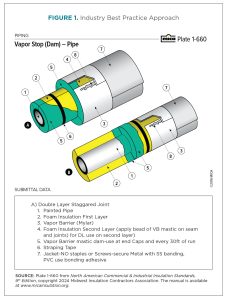NIA Contractor Member Kerco Discusses System Design
NIA is proud of the professionalism, creativity, and artistry of our Contractor members. To celebrate the craftsmanship of NIA mechanical and industrial insulation contractors, in 2023 we unveiled the first-ever NIA Insulation Project Art Gallery Showcase and Competition. We invited all NIA insulation contractors to submit photographs and a brief description of projects representing their most creative and artistic efforts. At Fall Summit, we posted all the submissions anonymously, and attendees voted for the top three projects in terms of number of parts insulated, aesthetics, difficulty of installation, and well-installed application. As a new regular column, we will profile the projects submitted, focusing this month on Kerco, Inc. We encourage NIA Contractor members to participate in the 2024 Insulation Project Art Gallery Showcase and Competition to possibly be featured in future articles.
PROJECT SNAPSHOT
- Type–Polyisocyanurate
- Manufacturer–DUNA-USA
- Fabricator–Insul-Therm
- International, Inc.
- Interior–PVC (in various colors)
- Exterior (on roof)–.024 white aluminum with 3/4” stainless steel banding (no screws or staples)
- Type–Mylar Vapor Barrier
- Brand–Childers
Project Description and Goals
The project involved insulating a refrigeration system for a new cold storage warehouse/process facility operating at below-ambient temperatures ranging from -40⁰F to 25⁰F. Pipes and equipment to be insulated run ammonia (-40⁰F and -25⁰F) and glycol (25⁰F), with temperatures on the piping schedule as follows:
- Blast and cell freezer at -35⁰F,
- Freezer at -10⁰F,
- Dock at 10⁰F, and
- Glycol at 25⁰F.
Goals of the project were to achieve energy savings by optimizing process efficiency (minimizing heat loss/gain in the system) and to control condensation. In addition, the customer sought to make the complex refrigeration system easier for maintenance personnel to work with by clearly delineating different process lines and temperatures, which offered the additional benefit of enhancing personnel safety.
Challenges
Sometimes the strengths of a project also present its greatest challenges. James Kerco, President of Kerco, Inc., has been in the commercial and industrial mechanical insulation industry for more than 45 years. He says, “The project was extremely well engineered, using colored PVC jacketing indoors to signify the temperature or type of system being insulated by color.” In the dock area, for example, colors were used to indicate the purpose of each pipe—condensate drain, hot gas line, refrigeration line, etc. (see Photo 1). If system repairs need to be made in the future, the colors will make it easy to isolate the line in question. While this simplifies things for facility maintenance personnel, it created a challenge for insulation installation: More than half a dozen colors were to be used, and the right color of jacketing needed to be applied to each pipe and piece of equipment insulated (along with the usual considerations, such as appropriate thickness, etc.).
System Design
Inside the facility, Kerco used polyisocyanurate insulation, with a mylar vapor barrier, applied to pipes and vessels. For condensation control, as well as process efficiency, Kerco personnel ensured insulation was installed at the correct thickness for the specific application, given the temperature of the individual pipes and the ambient temperature of the room where they were located. They used a staggered joint approach, with vapor barrier mastic applied to all seams and joints. Per specifications (and industry best practice), they applied vapor stops and expansion joints, and back-filled all voids with foam. MICA Plate 1-660 illustrates the approach they followed (see Figure 1). “We like to get [the MICA plate] on site to show how we will insulate and seal the pipe, and to educate the end user and the engineer,” James Kerco explains. “It is so important to insulate and seal particular types of insulation systems correctly. You miss one step, and you ruin the entire refrigeration system. The system can be completely destroyed within a year or two” because it was not insulated, or was not insulated properly. In contrast, Kerco adds, a sound insulation system will perform to expectations for so long that “by doing it correctly once, you don’t have to do it again.”
In both the process room and the engine room, pipes and vessels were color-coded using .030 PVC jacketing to indicate the temperature or type of system insulated (see Photo 2). The goal was for facility personnel to be able to walk into the engine room, for example, and know even from a distance what system/temperature each pipe or piece of equipment is.
As noted earlier, this feature presented a real test for the installation group, who had to “meet the challenge that all the PVC went on correctly on each system, making sure nothing was mislabeled,” James Kerco describes. To make sure the correct colors went on each piece insulated—while ensuring the correct insulation thickness was applied to each piping system—Kerco personnel insulated one system at a time, “working hand-in-hand with the refrigeration contractors” so everything was accurate.
Kerco also insulated exterior lines on the roof that provide service to the freezers, blast cells, and dock area (see Photo 3). They used .024 aluminum (painted white), with ¾ inch white stainless steel banding. The banding was essential. James Kerco notes, “You can’t use staples or screws in refrigeration jobs because you would violate the integrity of the vapor barrier. That’s the number one item that needs preservation. If that’s defeated, the system will fail.”
Table 1 offers an overview of insulation system components, listed by location.
The “Wow” Factor
James Kerco says that when facility personnel walked through the finished product, “Everyone was starstruck because of all the different colors—especially the refrigeration plant engineer and operating engineer for the refrigeration system.” Instead of the typical all-white system with labels indicating what ran inside each pipe, at what process temperature, “everything was color-coded, and they understood immediately what the colors meant.” In the end, while the use of color required that extra level of attention to detail during installation, the results were more than worth it in terms of immediate customer satisfaction and the long-term benefits of ease of maintenance and personnel safety.
Emphasis on Safety
James Kerco also stresses that completing a project on time, within budget, and achieving all the customer’s objectives is only part of the job. It is also vital that “we make sure all our employees go home safe at night.” In the pursuit of that mission, Kerco, Inc. is a 2023 NIA Safety Star™, awarded a Bronze Safety Excellence Award in April. As part of the company’s safety plan, in addition to attending regular general safety training and on-site project safety meetings, all Kerco field personnel are specifically trained on the equipment (e.g., forklift operation) and tasks they perform, and all are OSHA 10 certified; superintendents are OSHA 30 certified; and craftsmen and staff alike are trained in CPR. On this project, Kerco’s commitment meant that not only was the customer satisfied, but all Kerco employees were safe at the end of the day.
Project Takeaways
Many aspects of work performance contributed to the project’s success, but the takeaways listed below stand out as elements that are applicable to all insulation projects, whether new construction or upgrades.
- Communication Is Key. While coordinating schedules among different trades often can be a challenge with new construction projects, James Kerco says that working with the general contractor/refrigeration contractor kept everything running smoothly on this job. He notes, “Communication went well. Everyone knew what had to be done, and we were able to apply the insulation quite well without interruption.”
- Start with a Sound Design and Install per Best Practices. A well-engineered, well-specified plan executed by well-trained, experienced personnel following industrybest practices virtually guarantees that project goals will be met or exceeded.
- Planning Ahead Lowers Risk—and Stress. To ensure that all the materials were available in time, Kerco preordered those that typically require longer lead times, such as the white-painted jacketing used on the roof (which needed to be fabricated).
- Strength in Numbers. This project offers a real-world example of NIA President Jack Bittner’s theme, Strength in Numbers, as Kerco coordinated with fellow NIA member Insul-Therm International, Inc. (www.insultherminc.com) for fabrication of the polyisocyanurate insulation for the pipes and fittings, which was manufactured by NIA Associate member DUNA-USA (www.dunagroup.com/usa).
Energy Savings
James Kerco observes that although insulation is often among the last products considered, it is one of the most critical parts of a project, especially when it comes to energy savings. He notes, “We’ve been the energy people since insulation began. We were at the forefront when we initially began insulating pipes. We were conserving energy from Day 1.” Now, as so many in government and industry are looking for ways to achieve sustainability, that is a message worth repeating.
About Kerco, Inc.
Kerco is an industry leader in effectively utilizing 21st Century technology to better serve its clients. Using the latest in computer technology, the company can produce fast, accurate, and detailed on-site bids that take into account individual requirements, applicable government regulations, and clients’ design objectives. Kerco’s seasoned craftsmen provide the highest levels of service and technical support in the installation and maintenance of energy retention systems that impede heat gain or loss. For more information, visit www.kercoinc.com.






